Premium Theater Sound: Choosing An Audio Format With Acoustics In Mind
James Lindenschmidt
When we acoustically treat a theater after it has already been built, we must adapt our treatment strategies to the theater as it exists already. Inevitably, this leads to compromises and sub-optimal performance. We can always get better results if we look at a theater with acoustics in mind from the beginning, during the planning stages. If you are reading this while still in the design phase for your theater, then congratulations! By including acoustics considerations in your design, we can get much better results. We can plan ahead for the placement of acoustic treatments along with the seating strategy, screen size, and speaker placements.
Speaker placement strategies will depend on the audio format selected. There are multiple options here, from 2-channel stereo to the well-established 5.1 scheme, to the cutting-edge Immersive Surround systems with even more drivers throughout the room (Dolby Atmos, DTS:X, and Auro 3D are some of these). The specifics of speaker placement are somewhat flexible from plan to plan, but most call for 9, 11, or even 13 speakers in specific spots of the room, along with subwoofers. These more advanced formats are interesting developments, but one thing is clear: in order to perform optimally, they must be well-integrated into the room and the acoustic treatment strategy. In fact, the acoustics of the room and the treatment strategies employed should be a big part of choosing which format is most optimal and cost-effective in the available space.
This article examines the most popular audio formats in use today in theaters, treatment strategies for all of the formats, as well as tips on how to choose which format is right for you from a room acoustics point of view.
2 channel
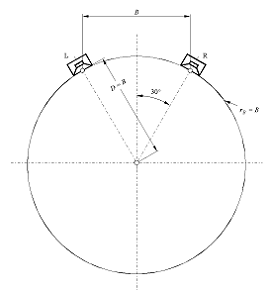
Today everyone is familiar with 2-channel, stereo sound. Every audio system comes with at least 2 speakers and can reproduce stereo recordings without any additional equipment or converters. Even our smartphones today are capable of playing stereo sound into earbuds for a private soundscape. But not everyone knows that Alan Blumlein’s early experiments with stereophonic sound using two speakers were rooted in cinema. In 1931, the anecdote goes, he saw a new “talkie” film with monophonic sound and was distracted when sounds appeared to come from the side of the screen where the speaker was, and not where the character or sound source actually was onscreen. This inspired him to experiment, and his pioneering work (among others) resulted in sterephonic sound becoming nearly universal.
It’s important to note that a well-executed 2-channel system is capable of reproducing a very lifelike soundstage without additional adornment from other speakers. But to reach these lofty heights, a humble 2-channel setup requires care in component selection (particularly of the speakers), layout & room setup, and the acoustic treatment strategy. Since the 2-channel stereo system is the simplest audio format to use, it is a good place to review all the basic strategies at play for maximizing the sound of any sort of listening room – including theaters. These basic strategies include: proper positioning of the speakers and the listening spot, broadband bass trapping, early reflection management and overall balance, ambience, and decay time tweaking. If you aren’t familiar with these concepts, then here is a good place to begin:
Remember: the goal of any treatment strategy is to increase the accuracy and intelligibility of the audio system. If all these strategies are well-implemented, then your equipment will be able to deliver the best possible performance, and a three-dimensional soundstage with stunning realism is possible. It cannot be overstated what a game changer treatment is. I’d much rather have a 2-channel system in a well treated room than the latest state of the art Immersive sound installation with no attention paid to room treatment, as it would to my ear provide a superior listening experience.
If you have implemented all these treatment strategies into your 2-channel design, but want to take your theater to the next level, you can think about expanding the number of speakers in the room.
Next Level: 5.1
The next stage to look at is a 5.1 setup, which adds 1 center channel speaker, 2 rear surround speakers, and a subwoofer. The most common implementations of 5.1 surround sound are Dolby Digital, Dolby Pro Logic II, DTS, SDDS, and THX, having first been conceptualized in the mid-1970s, as Quad (a 4-channel system) was on the decline. The center channel gives more control over the soundstage allowing us to make sure certain elements (such as movie dialogue) doesn’t get “lost in the shuffle” of all the stereo information coming from the left & right speakers. The rear surround speakers then put sound behind us which is key to the very concept of surround sound. And the subwoofer – or the .1 of 5.1 – is required for these systems to perform as designed in terms of low frequency bass extension, important for certain genres of both music and video.
The ideal setup for a 5.1 system was described in detail by The Recording Academy’s Engineers & Producers Wing in a 2004 document that includes the following diagram:
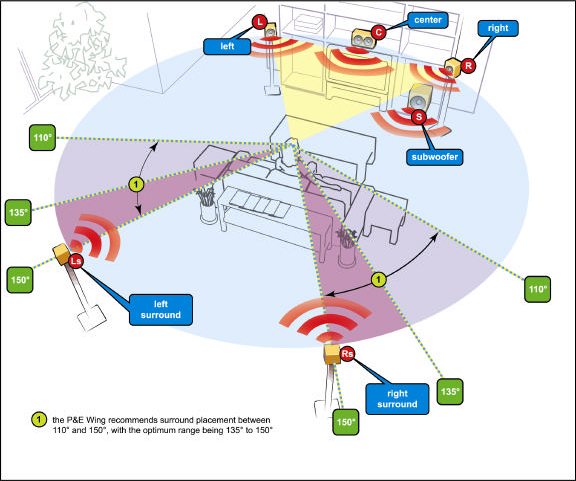
Note a few highlights of their recommended setup: all 5 speakers (except the subwoofer) are ear level. The center speaker is on the same left/right axis as the listener, with the left & right speakers 30° off center, making an equilateral triangle with the listener’s head. The 2 surround speakers are between 110° and 150° off center, behind and to the side of the listening position.
These are very specific placements, and if the placement isn’t accurate, the sound will suffer, and will not be experienced the way it was designed to be by the filmmakers and mix engineers. So the first question a new theater designer should ask is: “do I have the space in my room to properly place all six of these speakers?” Small rooms, particularly small rooms with a lot of stuff in them, won’t have room for a bunch of speakers to be properly placed relative to the listening position. If this describes your room, then you might consider that you may be better off with a simple 2-channel system than by adding more suboptimally-placed speakers to confuse your soundstage.
If you are lucky enough to have the space and flexibility to properly place the speakers for 5.1, then the second question might be even more important for good sound: “do I have the space in my room to properly place all the acoustic panels needed for all six of these speakers to perform at their peak?” The idea for all of these listening setups is to create a Reflection-Free Zone at the listening position. A Reflection Free Zone means no early reflections are able to reach our ears, which is a game-changer in terms of improving clarity and depth of soundstage. To brush up on how to find your early reflections, watch for the “mirror trick” in this video:
Note that there are many more early reflections than there are speakers. All the speakers in most small rooms will reflect off the ceiling, floor, left wall, right wall, and possibly the rear wall in very small rooms, all within 25 milliseconds or so. This gives us 5 early reflection points for each speaker, though more complex rooms are likely to have even more reflections. So a simple rectangular room with 2 speakers set up properly will have at least 10 early reflection points, whereas a 5.1 theater will have more than 25. Ideally, each of these reflection points should be treated with absorptive panels, so you can see that the treatment strategy becomes more complex with the additional speakers. In smaller rooms, this can be mitigated somewhat since more than one reflection point can be covered with just one panel. It’s best to cover all of them, though the front three speakers are the most important to maximize intelligibility, vividness, and detail in the soundstage. The point is, more panels are needed for more reflection points, in addition to the bass traps employed in the corners and elsewhere.
5.1 systems do have several things going for them, if you are going to venture beyond a simple stereo setup. 5.1 is currently the closest thing we have to a universal surround sound standard. Albums and videos mixed for surround are most likely to be mixed for a 5.1 setup as 5.1 has been in wide use for many years and likely will not be going away anytime soon, even as larger, more complex schemes have arrived. This means that if a given album or film is mixed in surround sound at all, it will almost certainly be compatible with your 5.1 setup. But for some, being on the cutting edge is preferable to being in a comfortable space, even if it means being patient for widespread compatibility to catch up with your system.
Immersive Surround
A third option for theater designers has arisen within the past decade, as more expansive theater audio formats have generated some excitement and buzz. These “immersive surround” schemes are all slightly different, with several possible setups available in the Dolby Atmos, DTS:X, and Auro 3D schemes. While there are some important differences between these schemes, all of them rely on additional speakers higher up in the listening room to add a height layer to the aural experience. Some of the larger schemes add a third top layer used for overhead effects, such as airplanes passing. For instance, one of the Auro 3D schemes (Auro 11.1 in this case) is designed as follows: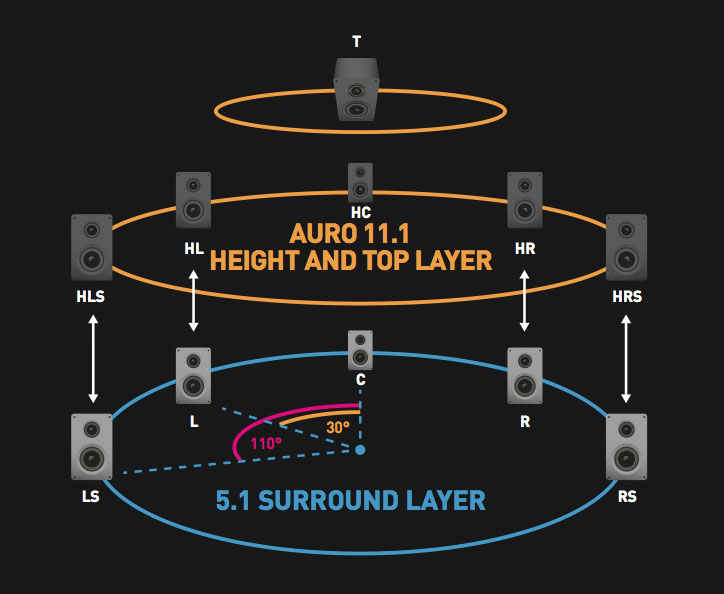
Note that this scheme essentially doubles the traditional 5 speaker setup in 5.1, by adding a second speaker at the height dimension, each about 30° higher than the 5 main speakers. An 11th speaker provides the “top” dimension at the very top center of the room, directly above the listener. Again, this is just one (Auro 11.1) manifestation of Auro 3D; there are many others including Auro 9.1, Auro 10.1, and Auro 13.1.
Other configurations are slightly different. For instance, the Dolby Atmos 5.1.4 scheme looks like this:
Once again, this design builds on the traditional 5.1 setup, this time by adding 4 overhead speakers. Dolby also departs from the traditional numbering scheme; while many would call this sort of setup a 9.1 system, Dolby calls it a 5.1.4 system, arguing that the 4 additional speakers are on a different height dimension from the rest and therefore should be considered separately. As with the other Immersive schemes, there are many kinds of Dolby Atmos setups including 5.1.4, 5.1.2, 7.1.4, and others all the way up to 9.1.6.
Note that with these sorts of setups, we can still think in terms of reflection points, and treating the above room to have a Reflection-Free Zone at the listening position. With all these immersive schemes, there are many more reflection points that will benefit from treatment to create a Reflection-Free Zone. However, one scheme of Dolby Atmos is different and is worth discussion: there is a line of “Atmos enabled” speakers that, rather than rely on discrete speakers mounted on the ceiling, instead have separate drivers mounted on top of the regular speakers, designed to bounce a sound wave off the ceiling and ricochet that channel’s sounds off the wall to you ear, as shown here: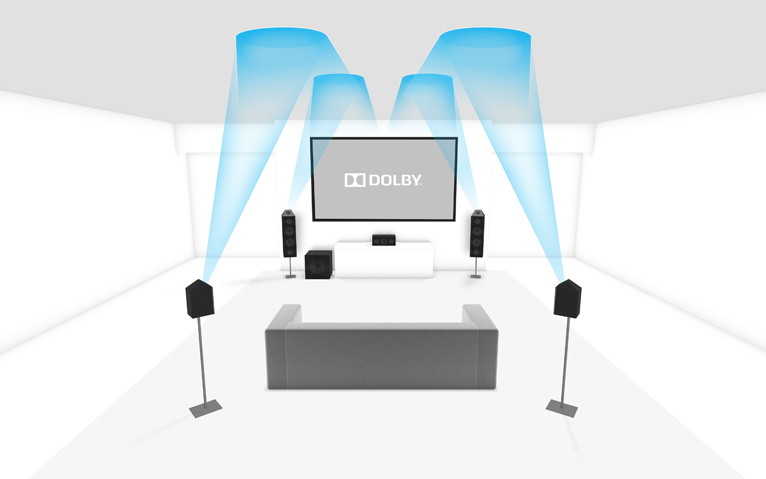
At best, this scheme is a compromise. Most people interested in room acoustics will be reluctant to recommend this scheme under any circumstances, since we know all-too-well what problems are created with reflections. First, even if the reflected sound is audible, the direct sound from the speaker will also be audible – and usually louder – than the reflected sound. Second, this direct sound will interfere with the reflected sound, mangling its frequency response by introducing peaks and nulls everywhere. Therefore, the localization cues will be muddled and our ears will be confused. Third, if we cannot use absorbers at reflection points with these “Atmos-enabled” speakers, then it is likely that we will not be able to use absorbers in nearby reflection points for other speakers, either, reducing the room’s sound quality even further. As such, the only scenario where this can be recommended is if aesthetic concerns prohibit using any acoustic treatment at all, and the listener wants to at least approximate sound from above, but these systems will never perform as well as other systems with good room treatments.
Takeaway Ideas
- Choose the audio format that best fits ALL the elements of your room, including the layout of speakers, listening spot(s), and acoustic treatment panels. If you cannot place a speaker in its recommended location, then consider using a simpler format.
- Add speakers and acoustic panels in the same proportions. If you can fit 5 or more speakers into your theater, then you should be able to find a place for some bass traps, absorbers, and diffusors. Your theater’s sound will thank you for it.
When In Doubt, Ask For Help
As always, we are happy to help you maximize the sonic potential of your room with our many years of experience and patented GIK Acoustic treatments. Contact us for free acoustical room advice.
Gallery: Home Theater Ideas
See our image gallery of GIK Acoustics acoustic treatments and bass traps in actual home theaters for inspiration and ideas for your home theater.



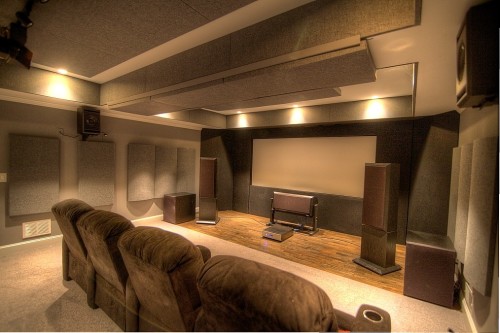
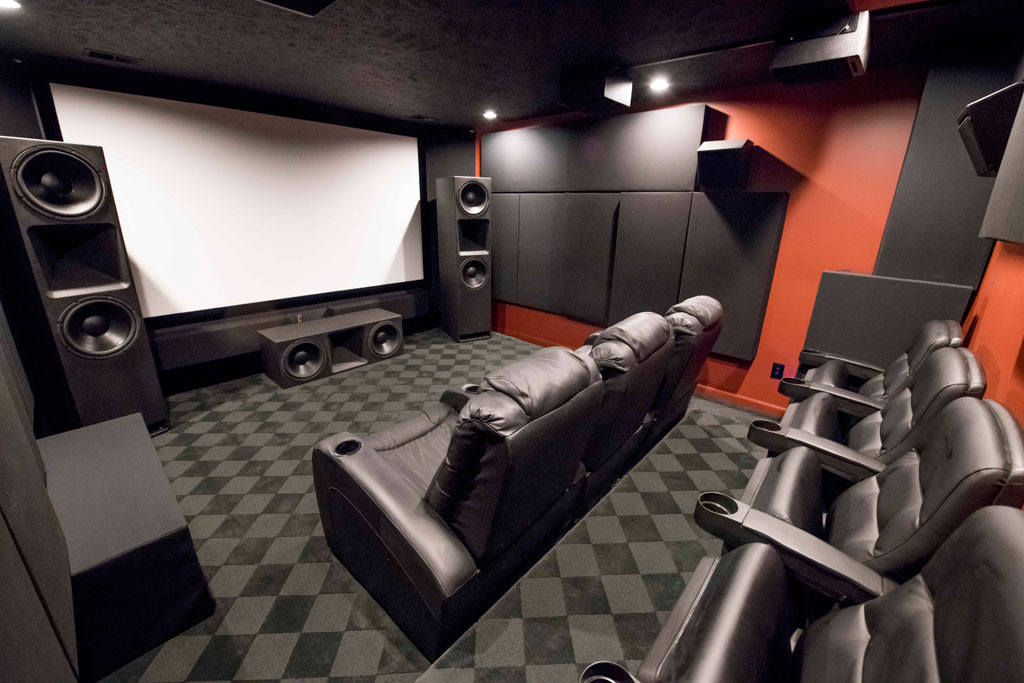
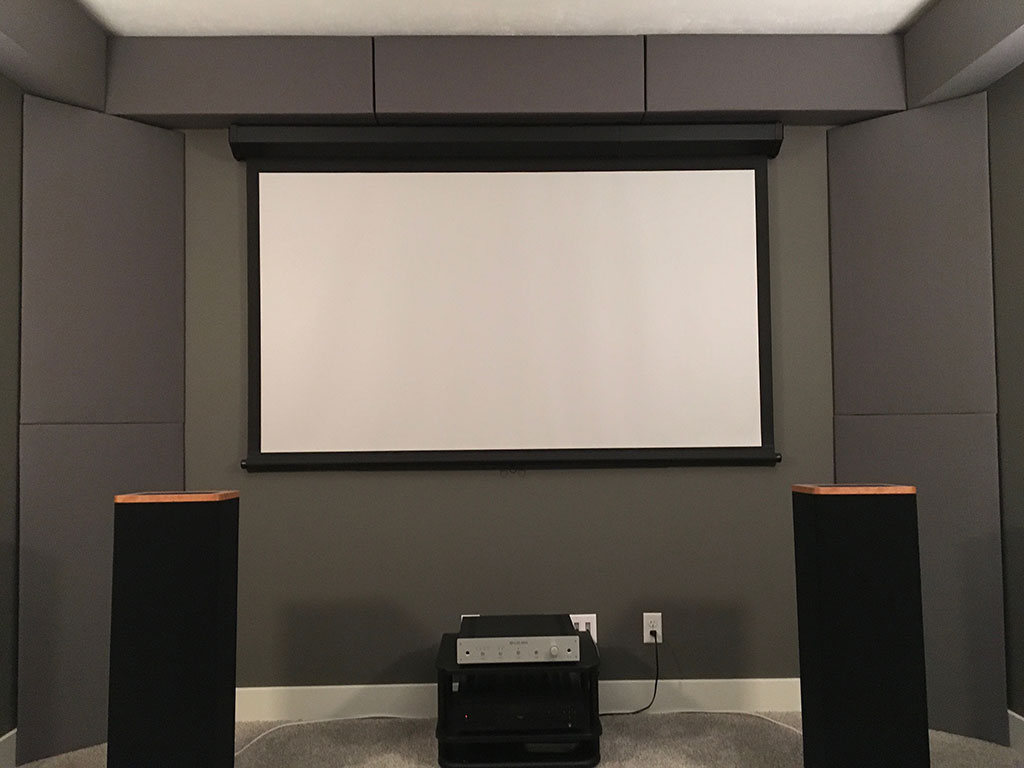
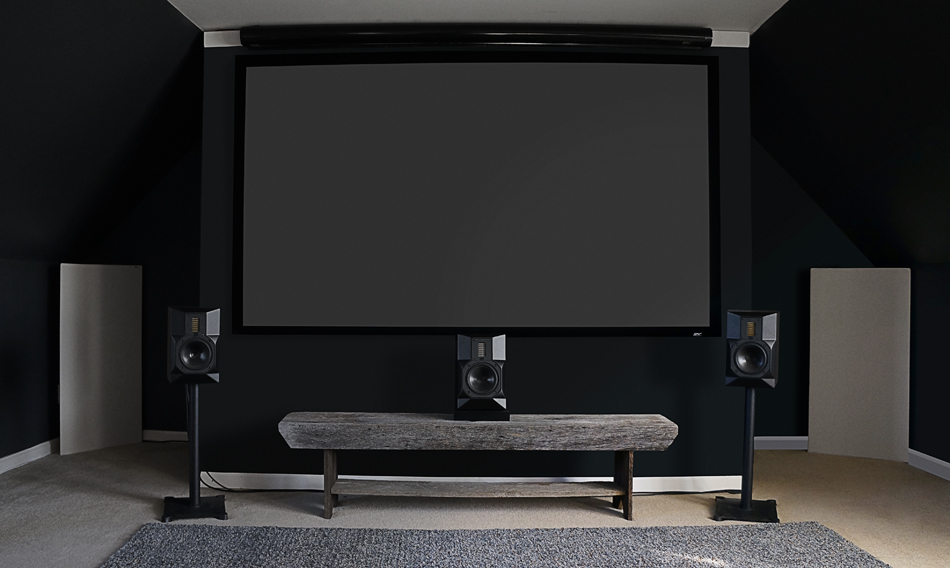
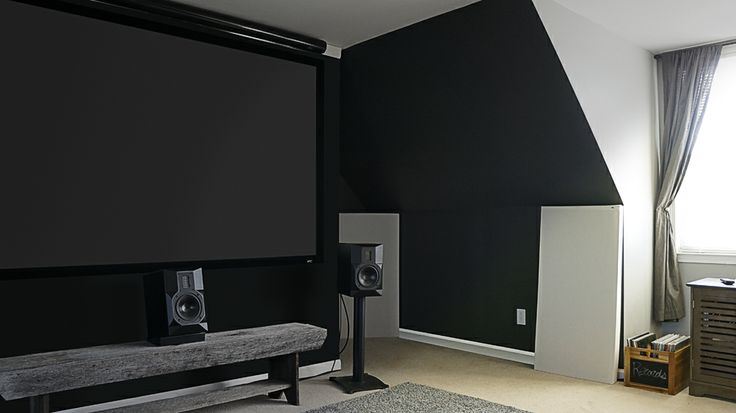
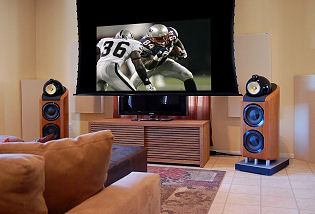
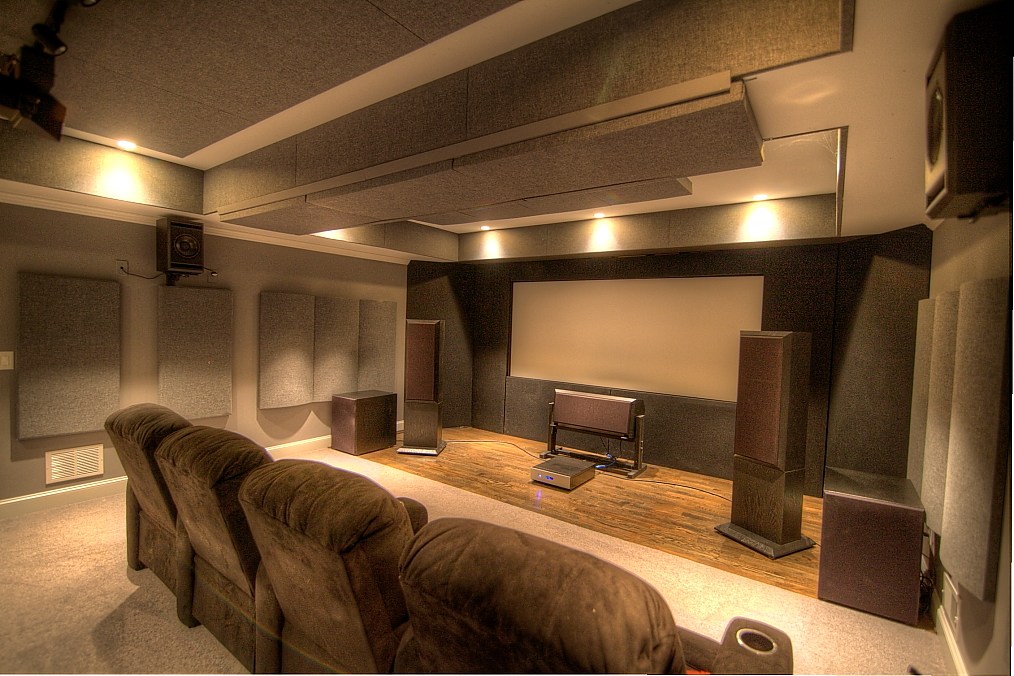
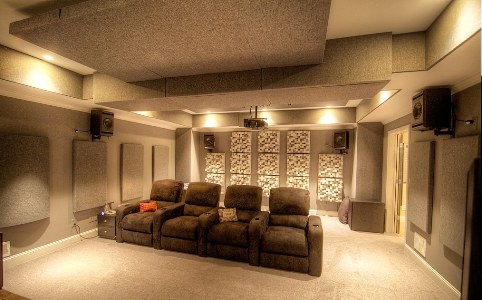
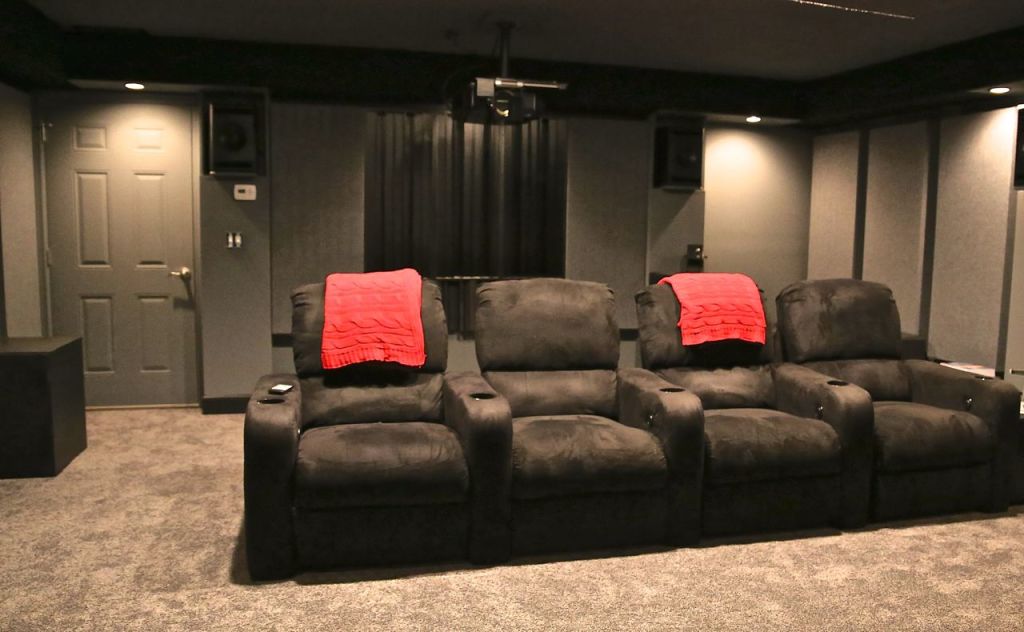
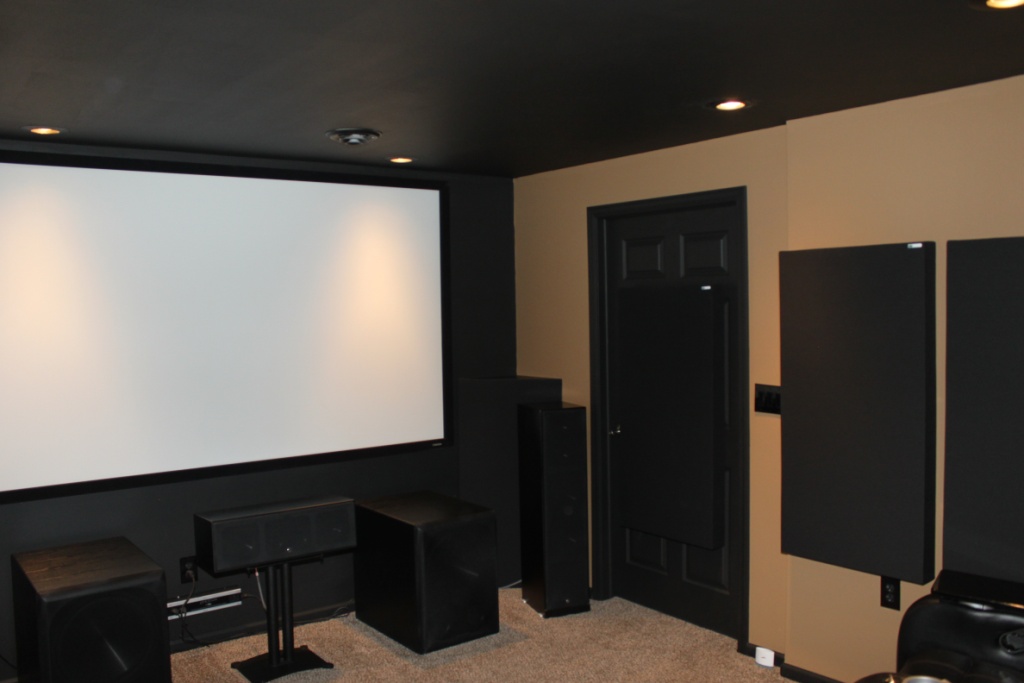
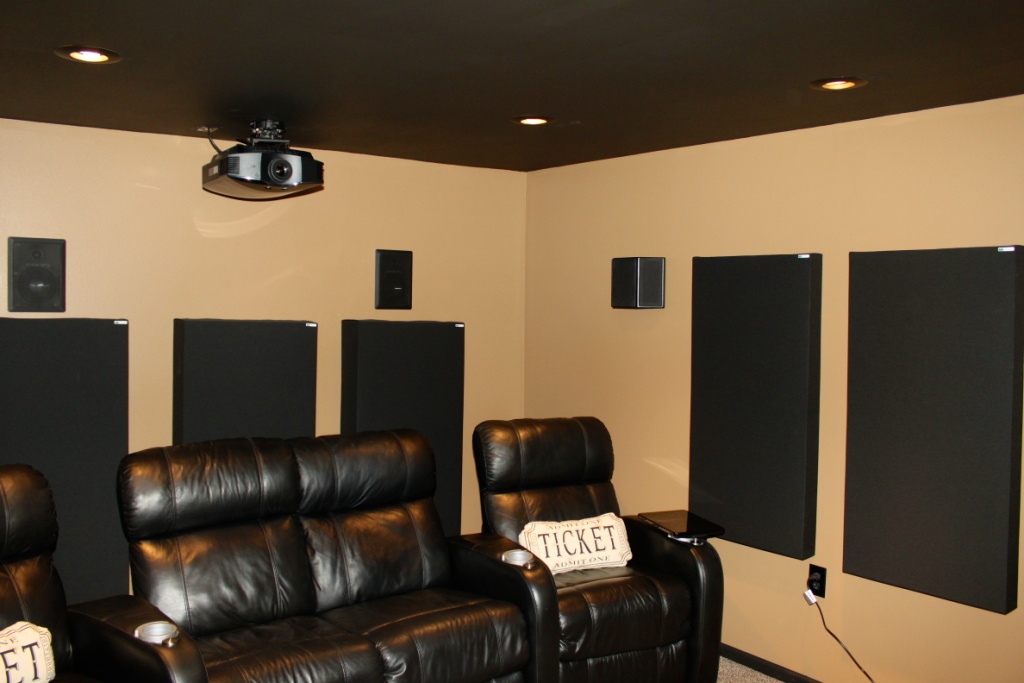
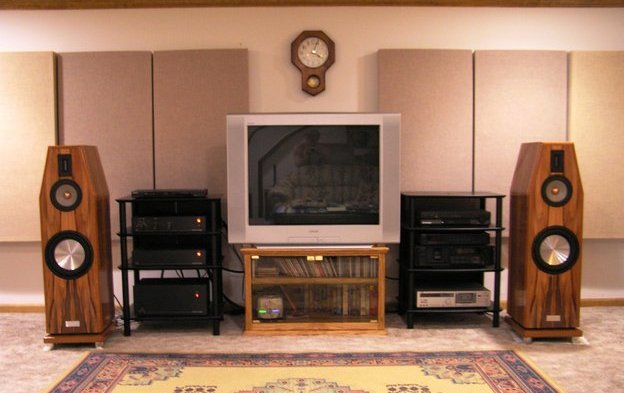
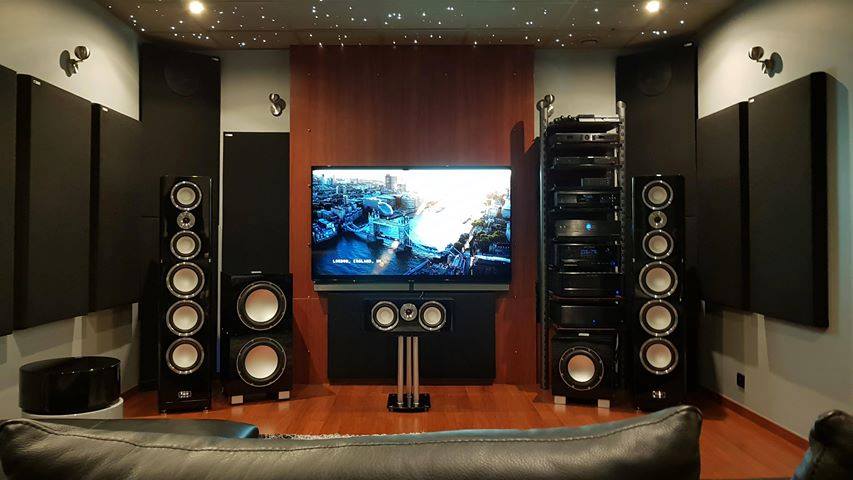
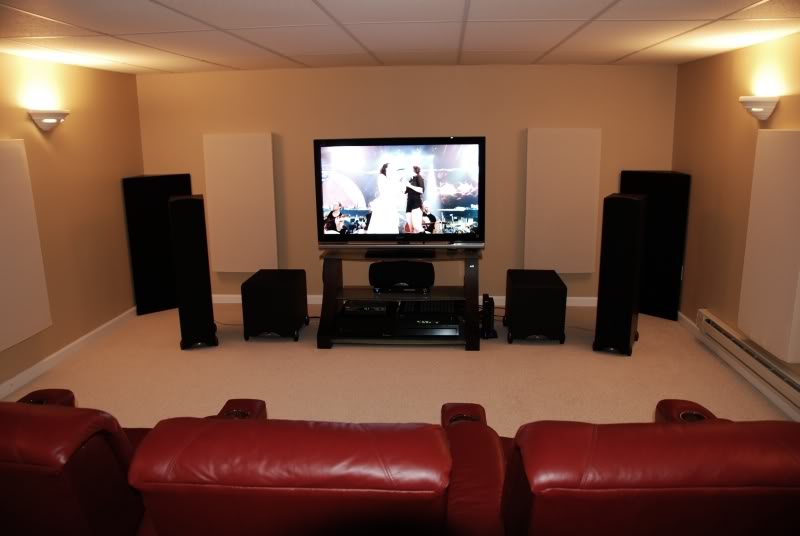
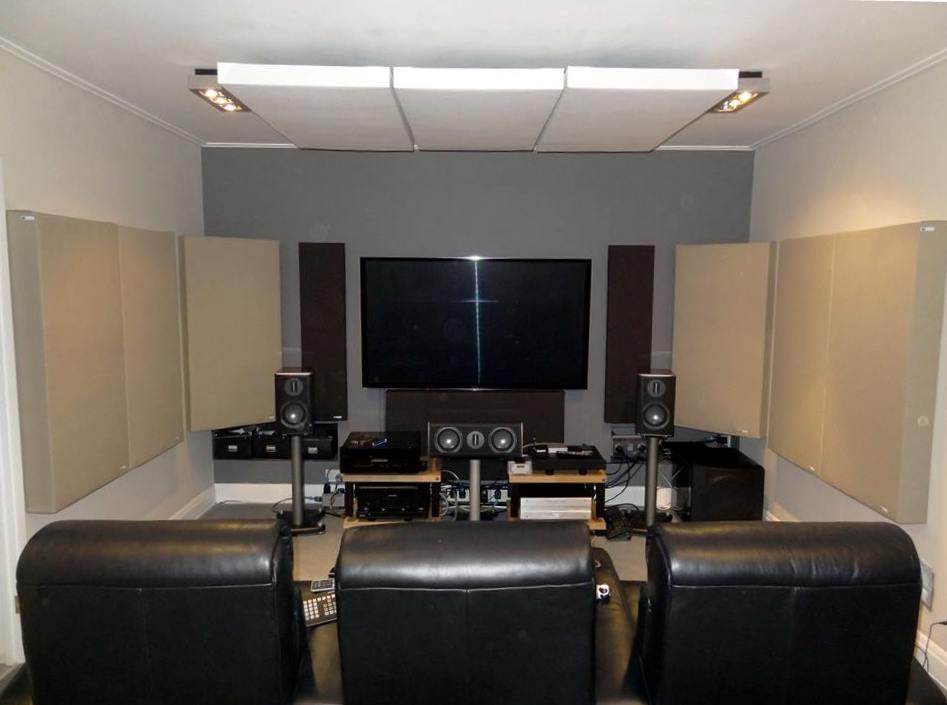

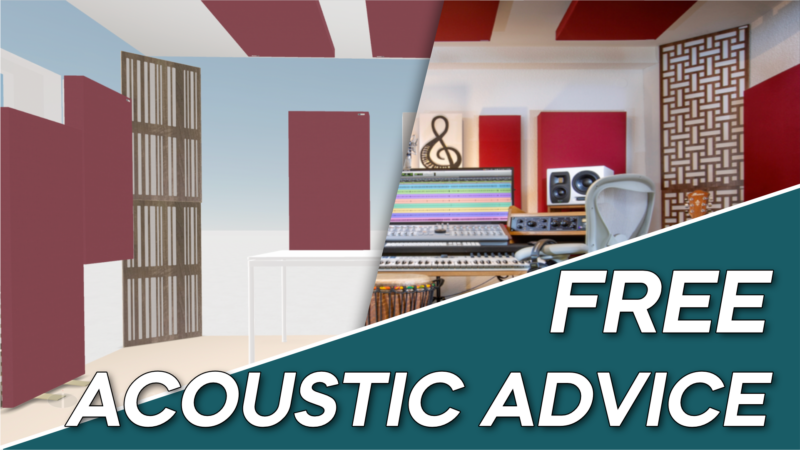
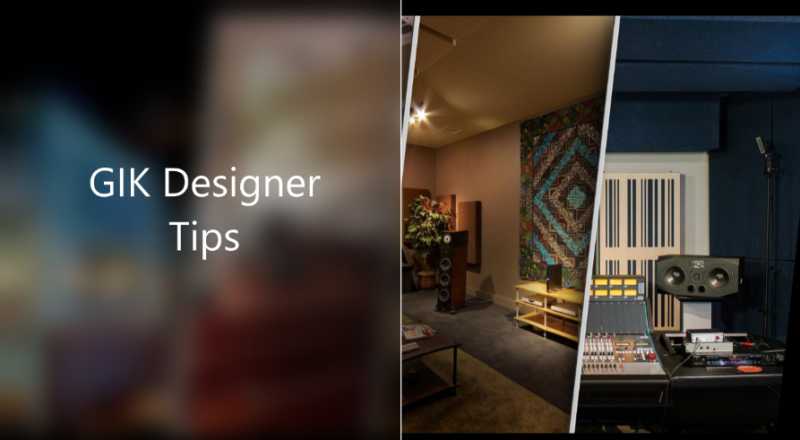


I definitely think it is important to get the acoustics right in your home theater. If not, things won’t sound that good. Great tips, thanks for sharing!
Thanks Laurie! I’m glad we agree on the importance of acoustics. :-)
I’m glad you enjoyed the article! I’m sure Sony still has its fans around…. there are so many manufacturers making great gear these days. But reviewing home theater gear & brands is beyond the scope of what we do. There are plenty of places to research gear…. the point being that quality acoustic treatment makes EVERYTHING sound better, regardless of brand! :-)
It really can be quite difficult to choose a proper sound system for your home theater, especially with how popular surround sound is nowadays. However, I really like that the article goes over several different kinds of setups to get the best quality out of your system. However, it might also help to talk to the company that you buy the sound system from and see what they suggest for the optimal setup.
hi Callum, Yes, I agree checking with the dealer or speaker manufacturer can help too…. though the principles in this article apply to just about any equipment you could choose for the room. The room will affect all equipment in the room in the same way. And as a caveat, I’ve heard of some audio equipment dealers having some strange ideas about room acoustics…. ;-) there are good ones out there for sure but not all of them have taken the time to learn about room acoustics.